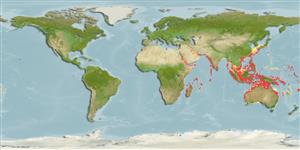Environment: milieu / climate zone / depth range / distribution range
Écologie
marin récifal; profondeur 2 - 95 m (Ref. 55723), usually ? - 25 m (Ref. 42181). Tropical
Indo-West Pacific: East Africa to Papua New Guinea, north to Taiwan (Ref. 11441) and the Philippines, south to the Great Barrier Reef (Ref. 33390). Also reported from the Saya de Malha Bank (76-95 meters) (Ref. 55723).
Taille / Poids / Âge
Maturity: Lm ? range ? - ? cm
Max length : 25.0 cm TL mâle / non sexé; (Ref. 48635)
Épines dorsales (Total) : 12; Rayons mous dorsaux (Total) : 9; Épines anales: 3; Rayons mous anaux: 5. Adults are best recognized by the tiny light-blue ocelli scattered over the body, and dark triangle below the eye. Small juveniles have three distinctive white spots along the back (Ref. 48635). A deep quadrangular occipital pit, its anterior edge, as viewed dorsally, with a slight ridge. A low ridge on each side of pit between tympanic and parietal spines. Pectoral rays strongly modally at 17 (Ref 42181).
Inhabits coastal reefs (Ref. 9710); usually taken by diving in protected areas of bays or lagoons, often where the fish can be well camouflaged in areas of algae, seagrass or sponge (Ref. 42181, 48635). Venomous spines. Occurs along continental margins or islands associated with continents, not at true oceanic islands (Ref 90102).
Life cycle and mating behavior
Maturité | Reproduction | Frai | Œufs | Fécondité | Larves
Randall, J.E., G.R. Allen and R.C. Steene, 1990. Fishes of the Great Barrier Reef and Coral Sea. University of Hawaii Press, Honolulu, Hawaii. 506 p. (Ref. 2334)
Statut dans la liste rouge de l'IUCN (Ref. 130435: Version 2024-2)
Utilisations par l'homme
Outils
Articles particuliers
Télécharger en XML
Sources Internet
Estimates based on models
Preferred temperature (Ref.
123201): 24.5 - 29, mean 28 °C (based on 766 cells).
Phylogenetic diversity index (Ref.
82804): PD
50 = 0.5000 [Uniqueness, from 0.5 = low to 2.0 = high].
Bayesian length-weight: a=0.01288 (0.00620 - 0.02676), b=3.03 (2.86 - 3.20), in cm total length, based on LWR estimates for this (Sub)family-body shape (Ref.
93245).
Niveau trophique (Ref.
69278): 4.2 ±0.8 se; based on size and trophs of closest relatives
Résilience (Ref.
120179): Milieu, temps minimum de doublement de population : 1,4 à 4,4 années (Preliminary K or Fecundity.).
Fishing Vulnerability (Ref.
59153): Low vulnerability (15 of 100).
Nutrients (Ref.
124155): Calcium = 59 [31, 117] mg/100g; Iron = 0.683 [0.366, 1.639] mg/100g; Protein = 18 [16, 20] %; Omega3 = 0.223 [0.101, 0.607] g/100g; Selenium = 31.6 [17.1, 77.8] μg/100g; VitaminA = 201 [70, 540] μg/100g; Zinc = 1.22 [0.84, 1.75] mg/100g (wet weight);
